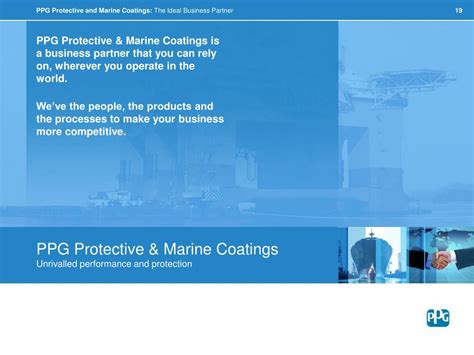Introduction
In the industrial and infrastructure sectors, protecting valuable assets from the ravages of corrosion, weathering, and wear is paramount. PPG Protective Coatings has emerged as a global leader in this arena, offering a comprehensive portfolio of coatings that safeguard assets and extend their service life.

Revolutionary Advancements in Surface Protection
PPG Protective Coatings has continuously pushed the boundaries of innovation, developing groundbreaking technologies that revolutionize surface protection. Their research and development efforts are driven by a deep understanding of industry challenges and a commitment to delivering cutting-edge solutions.
Over the past decade, PPG Protective Coatings has introduced several game-changing advancements, including:
- High-Performance Fluoroethylene Vinyl Ethers (FEVE): FEVE coatings provide exceptional color and gloss retention, withstand extreme weather conditions, and offer superior chemical resistance.
- Advanced Polyurethane (PU) Coatings: PU coatings offer excellent abrasion and chemical resistance, making them ideal for harsh industrial environments.
- Self-Healing Coatings: These coatings contain unique polymers that automatically repair minor scratches and damage, extending the life of the coating.
Coatings for Diverse Applications
PPG Protective Coatings caters to a wide range of industries and applications, including:
- Infrastructure: Bridges, pipelines, water treatment facilities, and other critical infrastructure benefit from the durability and corrosion resistance of PPG coatings.
- Industrial: Chemical plants, refineries, and heavy machinery rely on PPG coatings to protect against harsh chemicals, abrasion, and heat.
- Marine: Ships, offshore platforms, and submarines require coatings that withstand constant exposure to saltwater and UV radiation.
- Transportation: Automotive, aerospace, and rail applications demand coatings that provide corrosion protection, aesthetic appeal, and lightweight properties.
Key Statistics and Industry Impact
The impact of PPG Protective Coatings on the industry is evident in numerous statistics:
- According to a study by the National Association of Corrosion Engineers (NACE), the annual cost of corrosion in the United States exceeds $2.5 trillion. PPG coatings significantly reduce these costs by extending asset life.
- A survey by the American Coatings Association (ACA) found that the global coatings market is projected to reach $221 billion by 2026. PPG Protective Coatings holds a substantial market share within this growing industry.
Strategies for Effective Surface Protection
To achieve optimal surface protection, PPG Protective Coatings recommends a comprehensive approach:
- Proper Surface Preparation: Ensure the surface is clean, dry, and free of contaminants before applying the coating.
- Selection of the Right Coating: Choose the coating that best suits the intended application and environmental conditions.
- Application Techniques: Follow the manufacturer’s instructions for proper application, including recommended thickness and curing time.
- Ongoing Maintenance: Regularly inspect and maintain the coating to ensure it remains in optimal condition.
Case Studies: Real-World Applications
PPG Protective Coatings have been successfully used in numerous projects worldwide:
- The Golden Gate Bridge: PPG coatings protect the iconic bridge from the corrosive effects of saltwater and fog.
- The Burj Khalifa: PPG coatings provide long-lasting protection for the world’s tallest building.
- The International Space Station: PPG coatings shield the station from extreme temperatures and radiation in space.
Innovation Continues: Exploring New Horizons
PPG Protective Coatings is relentlessly committed to innovation, investing heavily in research and development. Their focus is on:
- Biomimetic Coatings: Inspired by nature, these coatings replicate protective mechanisms found in plants and animals to enhance durability.
- Waterborne Coatings: Reducing environmental impact and improving worker safety by minimizing VOC emissions.
- Smart Coatings: Incorporating sensors and other technologies to monitor coating conditions and trigger automatic repairs.
Conclusion
PPG Protective Coatings plays a crucial role in safeguarding critical infrastructure, machinery, and equipment worldwide. Their innovative coatings extend asset life, reduce maintenance costs, and improve overall performance. By embracing advanced technologies and a customer-centric approach, PPG Protective Coatings continues to set the industry standard for surface protection.
